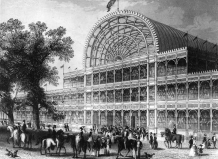Period Band C
Casts and Cultures: The Crystal Palace Sydenham
Tutor: Jason Edwards
Description
This module seeks to provide a detailed overview of the history of free-standing, architectural and relief sculpture, from the ancient Egyptian to the mid-nineteenth century, as articulated and understood within a single Victorian exhibition context.
Opened in 1854, in the enlarged and relocated buildings of the Great Exhibition of 1851, the Crystal Palace, Sydenham sought to tell the history of world culture through a series of historical and geographical courts – Egyptian, Assyrian, Alhambra, Greek, Roman, Pompeian, Byzantine and Romanesque, Medieval, Renaissance and Modern - housing thousands of plaster-cast reconstructions of representative objects and architectural fragments.
Visited by some 100 million people before it was finally razed to the ground in 1936, the Crystal Palace, Sydenham represented a perhaps still unprecedentedly encompassing art-historical canon for a popular audience, and a space in which Victorian curators and consumers were able to articulate and experience views on any number of issues, cultures and their inter-relations.
This module offers a sustained engagement with the surviving visual images of the Crystal Palace, Sydenham, alongside its various guide-books, to explore the ways in which the Victorians imagined, articulated and engaged with the cultures of world sculpture across a long durée, and, in so doing, with their own position as eminent modern subjects in an emphatically eclectic and cosmopolitan world.
Objectives
By the end of the module students should have acquired:
- A familiarity with and understanding of a wide range of imagery relating to the Crystal Palace, Sydenham.
- A detailed knowledge of the way in which the official guides to the Crystal Palace, Sydenham articulated Victorian historiographic and art-historical values.
- An ability to relate relevant archival and primary materials to more recent theorisations of Victorian eclecticism, cosmopolitanism, imperialism and cultural geography.
Preliminary Reading
Primary:
- Bonomi, Joseph and Owen Jones. Description of the Egyptian Court at the Crystal Palace (1854).
- Forbes, Edward. The Ethnological and Zoological Departments (1854).
- Jameson, Anna. Handbook to the Schools of Modern Sculpture (1854).
- Jones, Owen. An Apology for Colouring the Greek Courts of the Crystal Palace (1854).
- Jones, Owen. The Alhambra Court in the Crystal Palace (1854).
- Jones, Owen. A Grammar of Ornament (1856).
- Latham, Robert Gordon and Edward Forbes, The Natural History Department of the Crystal Palace (1854).
- Layard, A.H. The Ninevah Court in the Crystal Palace (1854).
- Owen, Richard. Geology and the Inhabitants of the Ancient World (1854).
- Phillips, Samuel. A Guide to the Crystal Palace and it Parks and Gardens (1854).
- Phillips, Samuel. The Portrait Gallery of the Crystal Palace (1854).
- Scharf, George. The Roman Court Erected in the Crystal Palace (1854).
- Scharf, George and Owen Jones. The Greek Court Erected in the Crystal Palace (1854).
- Scharf, George. The Pompeian Court in the Crystal Palace (1854).
- Scharf, George. Description of the Egyptian Court Erected in the Crystal Palace (1854).
- Wyatt, M. And J.B. Waring. The Italian Court in the Crystal Palace (1854).
- Wyatt, M. And J.B. Waring. The Byzantine and Romanesque Court in the Crystal Palace (1854).
- Wyatt, M. and J.B. Waring. The Medieval Court in the Crystal Palace (1854).
- Wyatt, M. and J.R. Waring. The Renaissance Court in the Crystal Palace (1854).
Secondary:
- Leith, Ian. Delamotte’s Crystal Palace: A Victorian Pleasure Dome Revealed (2005).
- Piggott, Jan. Palace of the People: The Crystal Palace at Sydenham 1854-1936 (2004).

Module code HOA00018I
